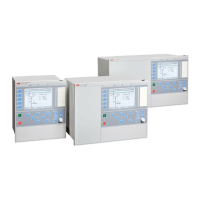Three phase network
VT
Fault in a measuring
circuit between
voltage transformer
and protection relay
e.g. blown fuse
REF 615
GUID-FA649B6A-B51E-47E2-8E37-EBA9CDEB2BF5 V2 EN
Figure 273: Fault in a circuit from the voltage transformer to the protection relay
A fuse failure occurs due to blown fuses, broken wires or intended substation
operations. The negative sequence component-based function can be used to detect
different types of single-phase or two-phase fuse failures. However, at least one of the
three circuits from the voltage transformers must be intact. The supporting delta-based
function can also detect a fuse failure due to three-phase interruptions.
In the negative sequence component-based part of the function, a fuse failure is
detected by comparing the calculated value of the negative sequence component
voltage to the negative sequence component current. The sequence entities are
calculated from the measured current and voltage data for all three phases. The
purpose of this function is to block voltage-dependent functions when a fuse failure is
detected. Since the voltage dependence differs between these functions, SEQSPVC
has two outputs for this purpose.
6.2.6 Signals
Table 537: SEQSPVC Input signals
Name
Type Default Description
I_A SIGNAL 0 Phase A current
I_B SIGNAL 0 Phase B current
I_C SIGNAL 0 Phase C current
I
2
SIGNAL 0 Negative sequence current
U_A_AB SIGNAL 0 Phase A voltage
U_B_BC SIGNAL 0 Phase B voltage
U_C_CA SIGNAL 0 Phase C voltage
U
2
SIGNAL 0 Negative phase sequence voltage
BLOCK BOOLEAN 0=False Block of function
Table continues on next page
Section 6 1MRS758755 A
Supervision functions
524 REC615 and RER615
Technical Manual

